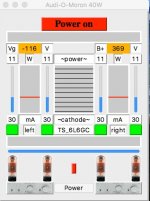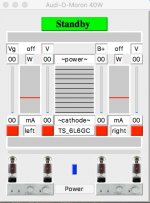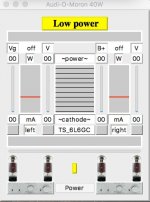We've all seen the analog bias boards supplied by Tent and Pavel at audioamp.eu, but has anyone ever though of using a microcontroller to do it?
Here is one, bottom of page:
the Presence Tube Amplifiers
These digital controller schemes generally have to shut off after power up sequencing, to avoid polluting the audio with digital noise. While an analog one can remain active during audio operation.
the Presence Tube Amplifiers
These digital controller schemes generally have to shut off after power up sequencing, to avoid polluting the audio with digital noise. While an analog one can remain active during audio operation.
That's pretty cool 🙂 A little old-school though? I was thinking more like an ATmel or something...
Jon: It might be easier, cheaper, and work better? Or there's the "For the hell of it" factor? 🙂
Jon: It might be easier, cheaper, and work better? Or there's the "For the hell of it" factor? 🙂
That's pretty cool 🙂 A little old-school though? I was thinking more like an ATmel or something...
Why old school? What do you reckon this is based on?
+1
Why does DIP mean it's old school? It says microcomputer. Don't know about now, but ATmel's used to be available as DIP, I have a few in my basement.
Why does DIP mean it's old school? It says microcomputer. Don't know about now, but ATmel's used to be available as DIP, I have a few in my basement.
I think bias should be left to change as it will, I am not the expert on bias. I know in class B it can go higher. I would vote for a bias motoring microcontroller which shuts down power if the bias is too high in one tube. Some kind of indicator too that the tubes need adjustment.
I think bias should be left to change as it will, I am not the expert on bias. I know in class B it can go higher. I would vote for a bias motoring microcontroller which shuts down power if the bias is too high in one tube. Some kind of indicator too that the tubes need adjustment.
A microcontroller with a2d would be able to monitor a few tubes bias and warn if too high.
Pete Millett did a nice looking 813 Amplifier quite a while back that used the Silicon Labs C8051F206 processor. He pulled the link from his website, I would guess perhaps because it uses very high voltages. The controller was used among other things to sequence the power up of filament, bias and B+ also measuring these so that if any of them were outside acceptable operating range the amp would power off. It's a neat chip.
I use PIC microcontrollers for all sorts of jobs in amplifiers.
I had a problem with an irs2092 being very noisy on power down.
So I monitor VCC and if it goes below a set voltage I hold the 2092 in reset via an opto coupler.
I had a problem with an irs2092 being very noisy on power down.
So I monitor VCC and if it goes below a set voltage I hold the 2092 in reset via an opto coupler.
Don't know if its still on his 'site but George (Tubelab) did a very high tech project at one stage with lots of highly offensive silicon and binary code to control its various functions including bias iirc
I used a RPi in mine - messing about with micro's and tubes..We've all seen the analog bias boards supplied by Tent and Pavel at audioamp.eu, but has anyone ever though of using a microcontroller to do it?
This amp is still in breadboard phase, it has turned out to be great fun, but I doubt it adds that much value to the sound, but has been interesting being able to plug in a variety of tubes and the micro sorts out the bias automatically.
I have recently written a graphics GUI that can control/monitor the amp remotely.
Attachments
Here is a video of the warmup sequence. The coloured squares show the relative emission of the 4 tubes (green > 80%) YouTube
And a video of the GUI while music is playing. The micro does not control bias when audio is detected. Unfortunately the recorded audio is poor, I was using the iMac internal microphone. YouTube
And a video of the GUI while music is playing. The micro does not control bias when audio is detected. Unfortunately the recorded audio is poor, I was using the iMac internal microphone. YouTube
Last edited:
Very cool! I was thinking of using a raspberry pi, Be able to monitor the voltages, biases, and currents in an android app.
Why old school? What do you reckon this is based on?
My just glancing it and thinking it used 74xxx series TTL chips. But I'm feeling much better now.
My just glancing it and thinking it used 74xxx series TTL chips. But I'm feeling much better now.
😀
Very cool! I was thinking of using a raspberry pi, Be able to monitor the voltages, biases, and currents in an android app.
A Pi is too slow booting up. Think arduino.
A Pi is too slow booting up. Think arduino.
Boot time is 10s, and it spends most of the time powered up with the amp power off.
I worked on a hughes and kettner using an Atmel to control bias and monitor for proper biasing, aka shut down the amp if it wouldn't fall into spec. Didn't have to work on that part of the circuit, so I don't know too much about its function.
Anyway, it seemed like a crime of sorts when I first saw it... Since then I still don't like it, but will probably use it when I get to designing my first big amp
Cory
Anyway, it seemed like a crime of sorts when I first saw it... Since then I still don't like it, but will probably use it when I get to designing my first big amp
Cory
Using automation reminds me of the 45kW Collins HF Linear Amplifier.
It had an Auto-tune feature of the output amplifier. It required a steady state carrier to the input (but that had to be set far below the 45KW level during the auto-tune routine). After it was tuned, then the full power Single Sideband signal could be applied to the amp input.
How about microprocessor automation with motors to turn the bias pots up and down during the Audio amp warm up routine (with mercury relays to turn off the audio signal inputs during the bias setting).
Well, probably not such a good idea, and too Rube Goldberg-ish.
It had an Auto-tune feature of the output amplifier. It required a steady state carrier to the input (but that had to be set far below the 45KW level during the auto-tune routine). After it was tuned, then the full power Single Sideband signal could be applied to the amp input.
How about microprocessor automation with motors to turn the bias pots up and down during the Audio amp warm up routine (with mercury relays to turn off the audio signal inputs during the bias setting).
Well, probably not such a good idea, and too Rube Goldberg-ish.
- Status
- Not open for further replies.
- Home
- Amplifiers
- Tubes / Valves
- microcontroller for bias?


